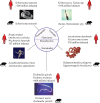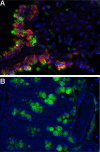Regulation of pathogenesis and immunity in helminth infections
- PMID: 19770272
- PMCID: PMC2757871
- DOI: 10.1084/jem.20091903
Regulation of pathogenesis and immunity in helminth infections
Abstract
Helminths are multicellular eukaryotic parasites that infect over one quarter of the world's population. Through coevolution with the human immune system, these organisms have learned to exploit immunoregulatory pathways, resulting in asymptomatic tolerance of infections in many individuals. When infections and the resulting immune responses become dysregulated, however, acute and chronic pathologies often develop. A recent international meeting focused on how these parasites modulate host immunity and how control of parasitic and immunopathological disease might be achieved.
Figures




References
-
- Bazzone L.E., Smith P.M., Rutitzky L.I., Shainheit M.G., Urban J.F., Setiawan T., Blum A.M., Weinstock J.V., Stadecker M.J. 2008. Coinfection with the intestinal nematode Heligmosomoides polygyrus markedly reduces hepatic egg-induced immunopathology and proinflammatory cytokines in mouse models of severe schistosomiasis.Infect. Immun. 76:5164–5172 doi:10.1128/IAI.00673-08 - DOI - PMC - PubMed
-
- Blount D., Hooi D., Feary J., Venn A., Telford G., Brown A., Britton J., Pritchard D. 2009. Immunological profiles of persons recruited for a randomized, placebo-controlled clinical trial of hookworm infection.Am. J. Trop. Med. Hyg. In press - PubMed
-
- Butterworth A.E., Dunne D.W., Fulford A.J., Thorne K.J., Gachuhi K., Ouma J.H., Sturrock R.F. 1992. Human immunity to Schistosoma mansoni: observations on mechanisms, and implications for control.Immunol. Invest. 21:391–407 doi:10.3109/08820139209069381 - DOI - PubMed
-
- Croese J., O’neil J., Masson J., Cooke S., Melrose W., Pritchard D., Speare R. 2006. A proof of concept study establishing Necator americanus in Crohn’s patients and reservoir donors.Gut. 55:136–137 doi:10.1136/gut.2005.079129 - DOI - PMC - PubMed

